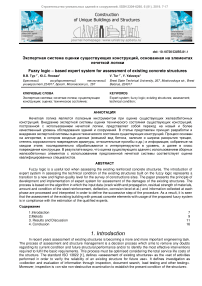Fuzzy logic - based expert system for assessment of existing concrete structures
Автор: Tur V.V., Yalavaya Y.S.
Журнал: Строительство уникальных зданий и сооружений @unistroy
Статья в выпуске: 6 (81), 2019 года.
Бесплатный доступ
Fuzzy logic is a useful tool when assessing the existing reinforced concrete structures. The introduction of expert system in assessing the technical condition of the existing structures built on the fuzzy logic represents a transition to a new and higher-quality level for the survey of constructions sites. The paper presents the principle of development and implementation of expert system for assessment of the damages of the existing structures. The process is based on the algorithm in which the input data (crack width and propagation, residual strength of materials, amount and condition of the steel reinforcement, deflection, corrosion level et al.) and information collected at each phase are processed and interpreted in order to define the successive step of the procedure. As a result, it is seen that the assessment of the existing building with precast concrete elements with usage of the proposed fuzzy system is in compliance with the estimation of the qualified experts.
Expert system, fuzzy logic, existing structures, assessment, technical condition
Короткий адрес: https://sciup.org/143170704
IDR: 143170704
Список литературы Fuzzy logic - based expert system for assessment of existing concrete structures
- ISO 13822:2010 Bases for Design of Structures - Assessment of Existing Structures. Geneva. International Organization for Standardization. 44 p.
- ISO 2394:2015 Reliability of Construction Structures. Geneva. International Organization for Standardization. 111 p.
- Mezzina, M., Uva, G., Greco, R. Decisional trees and fuzzy logic in the structural safety assessment of damaged R.C. buildings. 13th World Conference on Earthquake Engineering, Vancouver. 2004. Pp. 149-159.
- JRS, 2015 Scientific and Policy Report (N1247) New European Technical rules for the Assessment and Retrofitting of Existing Structures. Part III: Prospect for CEN Guidance. 125 p.
- Carbone, V.I., Mancini, G., Tondolo, F. Structural safety evaluation by means of fuzzy-probabilistic approach. Proceedings of the 29th Conference on Our World in Concrete & Structures, Singapore. 2004. Pp. 29-37.
- Zadeh, L.A. Fuzzy sets. Information and Control. 1965. Vol. 8. No. 3. Pp. 338-353.
- Badiru, A., Cheung, J. Fuzzy engineering expert systems with neural network applications. John Wiley&Sons, New York. 2002. 291 p.
- Khader, M. Hamdia Expert system for structural evaluation of reinforced concrete buildings in Gaza Strip using Fuzzy Logic. Master thesis, Islamic University of Gaza, Gaza Strip. 2010. 92 p.
- Chen, L.H. Fuzzy regression models using the least-squares method based on the concept of distance. Fuzzy Systems. 2009. Vol. 17. Pp. 1259-1272.
- Ross, T.J. Fuzzy logic with engineering applications. John Wiley&Sons, New York. 2004. 607 p.
- Weng, T.-L. A risk assessment model for buildings of reinforced concrete containing high concentrations of chloride ions. Journal of Marine Science and Technology. 2016. 23(5). Pp. 1016-1025.
- Mamdani, E.H., Assilian, S. An experiment in linguistic synthesis with a fuzzy logic controller. International Journal of Man-Machine Studies. 1975. Vol. 7. No. 1. Pp. 1-13.
- Choi, B.I., Rhee, C.H. Interval type-2 fuzzy membership function generation methods for pattern recognition. Information Sciences. 2009. Vol. 179. Pp. 2102-2122.
- Lundgren, K., Kettil, P., Hanjari, K.Z., Schlune, H., San Roman, A.S. Analytical model for the bond-slip behaviour of corroded ribbed reinforcement. Structure and Infrastructure Engineering. 2012. Vol. 8. No. 2. Pp. 157-169.
- Mak, M.W.T., Desnerck, P., Lees, J.M. Corrosion-induced cracking and bond strength in reinforced concrete. Construction and Building Materials. 2019. Vol. 208. Pp. 228-241.
- Jamali, A., Angst, U., Adey, B., Elsener, B. Modeling of corrosion-induced concrete cover cracking: A critical analysis. Construction and Building Materials. 2013. Vol. 42. Pp. 225-237.
- Coccia, S., Imperatore, S., Rinaldi, Z. Influence of corrosion on the bond strength of steel rebars in concrete Materials and Structures. 2016. 49 (1-2). Pp. 537-551.
- Andrade, C., Cesetti, A., Mancini, G., Tondolo, F. Estimating corrosion attack in reinforced concrete by means of crack opening. Structural Concrete. 2016. 17 (4). Pp. 533-540.
- fib Model Code for Concrete Structures 2010 / CEB-FIP Committee. Lausanne, 2013. 402 p.
- Tur, V.V., Yalavaya, Y.S. Influence of the reinforcing bar corrosion level on the flexural crack's width in the existing structure. Modern Engineering. 2019. Vol. 1. Pp. 1-9.


